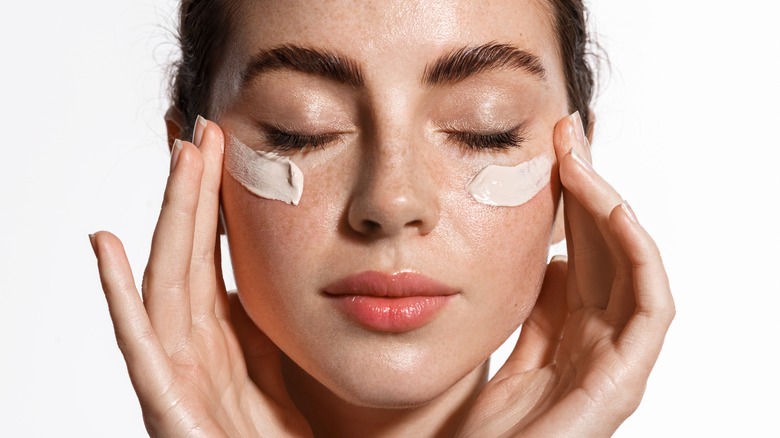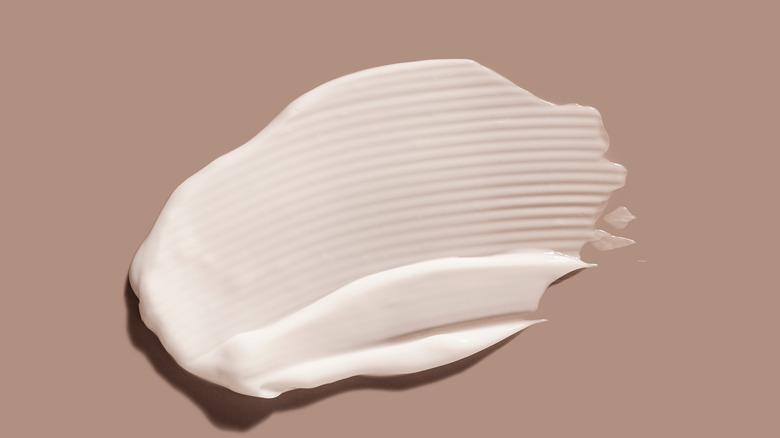What's A Barrier Cream And How Should You Use It?
While everyone loves the scent of a warm fall candle and the sound of crunchy leaves, the cold weather is a scary time for your skin. From dry winds to the bitter cold temperature, the arrival of the fall season is the start of the cold weather that can wreak havoc on your skin. If you have sensitive skin, this season is painful as colder weather can irritate and further aggravate skin conditions. On this, dermatologist Dr. Alejandra Estemalik, M.D., explains to the Cleveland Clinic, "In winter, environmental humidity is low. But we're also exposed to forced air or heat, which is also going to decrease humidity indoors and cause dry skin." Estemalik explains how this combination of factors can cause dryness, flakiness, and irritation to your skin, which leave it feeling cracked and uncomfortable.
However, with the proper skincare tools, your skin doesn't have to feel dry all season long. Having a hydrating skincare routine is essential if you want to help protect your skin, but one of the most vital parts of your skincare routine has to be your barrier cream. Even though more brands are looking to add barrier creams to their lineup, many people still do not understand how beneficial barrier creams can be, especially for those with sensitive skin. Although not as mainstream as a face moisturizer, barrier creams are your skin's key to surviving dry, cold weather.
What's a barrier cream?
The purpose of a barrier cream is simple; it's a cream that acts as a shield on your skin to help protect your skin from the dry, cold elements. The Skin Center explains that while barrier creams help protect your skin by acting as a shield, it also helps lock in the skin's moisture and alleviate areas of the skin that are dry and damaged. A multifunctioning product, barrier creams come for all areas of the skin, including the face, hands, and feet. The Skin Center recommends using a targeted skin barrier for the face, as these tend to be more breathable and won't clog your pores.
As opposed to your everyday moisturizer, barrier creams are usually thicker and are a step above just adding hydration. What's more, Dr. Joshua Zeichner tells PopSugar, "The goal of a moisturizer is to enhance skin hydration. At the same time, it may help provide a protective barrier over the skin. A barrier cream, on the other hand, may provide hydration but, at its root, is designed to help repair the skin barrier and allow the skin to heal itself." Barrier creams are created to help you alleviate a damaged skin barrier, which can cause irritation and cracking if not repaired.
The right way of using a barrier cream
As tempting as it is, use your barrier cream carefully. Odilyque recommends using barrier creams as the final step of your skincare routine. Since barrier creams lock in moisture and hydration, you'll want to apply plenty of moisturizing products before your barrier cream. If you apply products after your barrier cream, they will not penetrate the cream and will go unnoticed. You also want to apply barrier cream on skin that needs extra help with cracked or dry areas. While you can use this product any time, you'll want to focus your application during dry, cold seasons.
While face barrier creams are created to not cause acne, you want to be cautious with your application. Furthermore, Attn: Grace recommends thoroughly washing off your face in between uses to prevent clogging your pores. Although completely safe, try to avoid using your barrier creams often, to avoid product buildup. Many barrier creams are made out of ingredients that can help with inflammation and infections — two issues that tend to happen in colder climates.


